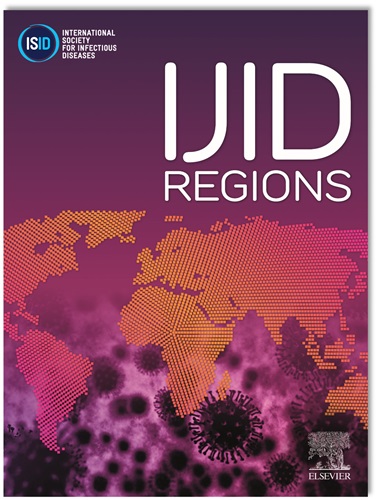Classic pathway persistent complement activation is associated with specific symptoms in individuals with post–COVID-19 condition: A case-control study
IF 4.3
2区 医学
Q1 INFECTIOUS DISEASES
引用次数: 0
Abstract
Objectives
The complement system is a crucial part of the immune system. The role of complement activation in post–COVID-19 condition is still not conclusive. We present a case-control study investigating long-lasting complement hyperactivation in COVID-19 survivors with/without post–COVID-19 condition.
Methods
A case-control (2:1 design) study was performed. Concentration levels of four proteins from classic complement pathway (C3, C4, C5, C7) and total hemolytic complement (CH50) activity were obtained from blood samples in group of survivors with post–COVID-19 condition and in a comparison group of survivors without post–COVID-19 condition, matched by age, sex, and vaccination status. Post–COVID-19 condition was defined when individuals self-reported at least one of these post–COVID-19 symptoms: fatigue, arthralgia, myalgia, memory problems, new-onset headache, or palpitations.
Results
A total of 57 (56.1% women, age: 46.5 years, SD: 9.0 years) survivors with post–COVID-19 condition and 27 (55.5% women, age: 46.5 years, SD: 11.5 years) survivors without post–COVID-19 condition were evaluated 1.7 (SD 1.2) and 2.0 (SD 1.7) years after SARS-CoV-2 infection, respectively. Overall, the results did not reveal differences in complement protein levels and CH50 activity between survivors with or without post–COVID-19 condition. Patients reporting post-COVID fatigue exhibited lower C3 levels (P = 0.025) than those without post-COVID fatigue, whereas survivors with post-COVID dyspnea reported lower levels of C3 (P = 0.001), C5 (P = 0.015), and C7 (P = 0.030) proteins than those without post-COVID dyspnea.
Conclusions
This explorative case-control study did not observe overall complement activation from classic pathway in survivors with post–COVID-19 condition up to 2 years after. Some complement proteins were elevated in individuals with specific post-COVID symptoms, such as fatigue or dyspnea.
经典途径持续补体激活与covid -19后个体的特定症状相关:一项病例对照研究
目的:补体系统是免疫系统的重要组成部分。补体激活在covid -19后病情中的作用尚不明确。我们提出了一项病例对照研究,调查有/无后COVID-19疾病的COVID-19幸存者的长期补体过度激活。方法:采用病例-对照(2:1设计)研究。从covid -19后疾病幸存者组和按年龄、性别和疫苗接种状况匹配的无covid -19后疾病幸存者组的血液样本中获得四种经典补体途径蛋白(C3、C4、C5、C7)的浓度水平以及总溶血性补体(CH50)活性。covid -19后症状是指个体自我报告至少一种covid -19后症状:疲劳、关节痛、肌痛、记忆问题、新发头痛或心悸。结果:在SARS-CoV-2感染后1.7年(SD 1.2)和2.0年(SD 1.7)分别对57名(56.1%女性,年龄:46.5,SD: 9.0岁)和27名(55.5%女性,年龄:46.5,SD: 11.5岁)无covid -19后症状的幸存者进行评估。总体而言,结果并未显示患有或未患有covid -19后疾病的幸存者之间补体蛋白水平和CH50活性的差异。报告covid后疲劳的患者比没有报告covid后疲劳的患者表现出较低的C3水平(P=0.025),而患有covid后呼吸困难的幸存者报告的C3 (P=0.001)、C5 (P=0.015)和C7 (P=0.030)蛋白水平低于没有covid后呼吸困难的幸存者。结论:这项探索性病例对照研究未观察到covid -19后病情存活两年后经典途径的总体补体激活。一些补体蛋白在出现特定的covid后症状(如疲劳或呼吸困难)的个体中升高。
本文章由计算机程序翻译,如有差异,请以英文原文为准。
求助全文
约1分钟内获得全文
求助全文
来源期刊
CiteScore
18.90
自引率
2.40%
发文量
1020
审稿时长
30 days
期刊介绍:
International Journal of Infectious Diseases (IJID)
Publisher: International Society for Infectious Diseases
Publication Frequency: Monthly
Type: Peer-reviewed, Open Access
Scope:
Publishes original clinical and laboratory-based research.
Reports clinical trials, reviews, and some case reports.
Focuses on epidemiology, clinical diagnosis, treatment, and control of infectious diseases.
Emphasizes diseases common in under-resourced countries.

 求助内容:
求助内容: 应助结果提醒方式:
应助结果提醒方式:


